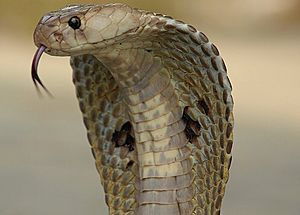Cobra facts for kids

A cobra is a type of venomous snake. Many cobras are known for their special ability to spread their neck ribs. This makes a wide, flat shape called a "hood." This hood is a warning sign to others.
The word "cobra" comes from Portuguese. It's short for cobra de capelo, which means "snake with a hood."
Cobras mostly live in warm, tropical, and desert areas. You can find them in Asia and Africa. When a cobra feels scared or threatened, it will lift the front part of its body. Then, it flattens its neck into that famous hood shape. This makes the snake look bigger and more dangerous. When they are not threatened, their heads look like other snakes.
What are "True Cobras"?
The snakes known as "true cobras" belong to a group called Naja. These cobras are famous for raising their bodies and flattening their necks. This is a clear warning signal. They are a type of snake called elapids. You can find them in Africa and Asia.
There are more than 20 different kinds of true cobras. Some well-known ones include:
- The Cape cobra (Naja nivea): This is a medium-sized cobra from southern Africa. It has very strong venom.
- The Egyptian cobra (Naja haje): This snake is sometimes thought to be Cleopatra's "asp."
- The Indian cobra (Naja naja): Also called the spectacled cobra, it's found in Asia.
- The monocled cobra (Naja kaouthia).
Spitting Cobras
Some types of Naja cobras are called Spitting cobras. These snakes can squirt their venom from their fangs. They do this to defend themselves, aiming for the eyes of a threat.
Other Snakes Called "Cobras"
Even though Naja snakes are the "true" cobras, other snakes are also called cobras. Here are a few:
- The rinkhals (Hemachatus haemachatus): This snake is also known as the ring-necked spitting cobra. It has a band around its neck and can also form a hood when threatened.
- The king cobra (Ophiophagus hannah): This is the longest venomous snake in the world!
- Tree cobras: These include Goldie's tree cobra (Pseudohaje goldii) and the black tree cobra (Pseudohaje nigra).
- Shield-nosed cobras: Such as the Cape coral snake (Aspidelaps lubricus) and the shield-nosed cobra (Aspidelaps scutatus).
- Black desert cobras: These are Walterinnesia aegyptia and Walterinnesia morgani. They don't usually raise their bodies or make a hood.
- The eastern coral snake (Micrurus fulvius): Also called the American cobra, it also doesn't raise its body or make a hood.
Most snakes called "cobras," including all the "true" cobras, belong to the snake family called Elapidae. However, there is one snake called the false water cobra (Hydrodynastes gigas) that is not part of this family. It doesn't raise its body much and only flattens its neck a little. Its venom is not very strong.
See also
 In Spanish: Cobra para niños
In Spanish: Cobra para niños

